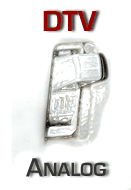
|
|
 |

|


Dick De Jong May 9, 2007 HDTV Solutions 651 days and counting down. On February 17, 2009, Congress has mandated that all television stations in the U.S. must stop transmitting analog TV signals and switch to digital. What impact will this "switch" have on you? Let's take a look at what this transition is and how it could affect a typical household. Probably the most important thing to know about this switch is that it concerns over-the-air (OTA) broadcasts. We're talking about receiving your TV signal from your local television stations through an antenna. Basically, if your TVs are hooked up to cable or satellites, you won't be effected. But if any of your TVs are receiving OTA signals - yes, even that old 19" TV in the guest room - then you should pay attention. And for those who are already digitally connected, you may want to stick around because in 600 days you might be getting a call from your grandmother who is worried that she won't be able to watch the local evening newscast. Also, people are getting confused about what this transition means in terms of programming. Since the 1950's, local TV stations have been broadcasting their signals from their big antenna to your TV's antenna through a modulated system that we now designate as analog. All TVs back then had a tuner that received the analog signal and displayed it on your set. Even today, every TV, even HDTVs have an analog, NTSC, tuner. Analog transmission never was the greatest and in the last few years, digital broadcasting has become popular because it is cleaner, clearer and more efficient. Congress and the FCC (Federal Communications Commission) have been planning to make the switch to digital for years. And in fact, many of the local TV stations around the country are already transmitting digital OTA signals along with separate analog signals. Now the problem is that your TV needs a digital, ATSC, tuner to receive the digital signal. In anticipation of the switch, the FCC mandated three dates in which all TVs entering the U.S. must have ATSC tuners. On July 1, 2005, all televisions with screen sizes over 36" needed ATSC tuners. On March 1, 2006, it included TVs 25" or larger. And on March 1 of 2007, all TVs must have an ATSC tuner. Of course, most TVs made before 2000 did not have an ATSC tuner. If your TV doesn't have one and you are relying on OTA analog signals, then you will need to buy a converter box for that TV. Beginning in 2008, the NTIA (National Telecommunications and Information Agency) will be giving two $40 coupons to households to defray the expense of digital to analog converter boxes, which they predict will cost about $50 – 80 a piece. For more information about the program, read: http://www.ntia.doc.gov/dtvcoupon/DTVconsumers.pdf To recap, if you are receiving over-the-air programming and your TV does not have a digital, ATSC tuner, then it will not be able to tune into your local stations after February 17, 2009 unless you purchase a digital to analog converter box. DTV Does Not Mean HDTV Now, there is one big misconception that I want to caution you about. If you read the news reports or publications about this switch, you will see the term DTV being bandied about. DTV stands for digital television, which, depending on who you are talking to, can mean a lot of different things. In the context of the transition from analog to digital, DTV is used to describe the new digital OTA broadcast system. In this use of DTV, we are talking about signals and not television sets or high definition. I received an email that was complaining about how much cable systems were charging for high definition programming and he said, "They're ripping us off before the mandate to go all HD." As you can see, the FCC has not mandated a transition to HD. The law only deals with a change to digital transmission and only then for OTA local channels. This switch will not marvelously morph our old SD TVs into HDTVs. And it is not going to magically change all the standard definition programming into high definition. I can understand the confusion because HD cannot be broadcast OTA by the old analog system. Only the digital, DTV system can carry HD shows. But if you are watching local OTA digital channels now on your HDTV, you know that most SD programs are broadcast in their 4:3 native format with gray columns on the side. They haven't been resized or upconverted just because they are being transmitted digitally. I realize that by February 17, 2009, more and more programs will be created and broadcast in HD. In fact, a number of stations are beginning to shoot their local evening news in HD. And even now, the purchase of HDTVs is beginning to outnumber standard definition TVs. The specter of this Congressional decision has definitely nudged the progression to HD, but it did not specifically mandate it. And for one last time, remember we are talking about local television stations, which depending on where you live means networks like ABC, CBS, CW, Fox, NBC, PBS, and Univision. The transition does not directly effect any of the cable networks like ESPN or TNT or HBO. If you think that cable companies are charging too much for their HD tier, this transition will not solve that problem. Stay tuned, |
Bookmark:
![]() del.icio.us
del.icio.us
![]() Reddit
Reddit
![]() Google
Google
| Send this Page | Print this Page | Report Errors |



